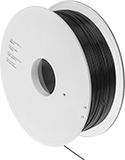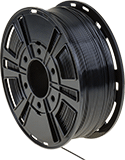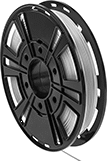Impact-Resistant ABS 3D Printer Filaments

Bumps, scrapes, and falls won’t damage these tough ABS filaments. Known for their durability, they absorb impact without cracking or breaking, and won’t degrade when heated. Use them to print tool handles, storage cases, and other parts that are handled or dropped frequently. These filaments are a good place to start if you’re experimenting with printing impact-resistant parts.
Use with a fused filament fabrication (FFF) 3D printer. These filaments have a high melting point and must be printed onto a heated bed. Without it, parts will cool too quickly and warp. These filaments also release fumes as they are printed, so use an enclosed printer or a fume exhauster to ventilate them. Fiberglass-filled ABS filaments make parts that are stronger and less likely to warp or shrink than ABS filaments without a filler. Carbon-fiber- and fiberglass-filled filaments are abrasive, so you should use them with an abrasion-resistant nozzle. They will wear out other nozzles.
Tensile strength is the best measure of a filament's overall strength. Similar to the stress applied on a rope during a game of tug-of-war, it's the amount of pulling force a material can handle before breaking. A higher rating means a stronger filament. A tensile strength of 5,000 psi and above is considered good; 12,000 psi and above is excellent.
Maximum exposure temperature is the point at which a printed part will begin to deform. Above this temperature, your printed parts will start to lose structural integrity.
Spool | |||||||||||
|---|---|---|---|---|---|---|---|---|---|---|---|
| Dia., mm | Printing Temp. | For Printer Bed Temp. | Tensile Strength | Max. Exposure Temp. | For Min. Nozzle Dia., mm | Dia., mm | Dp., mm | Wt., g | Color | Each | |
Fiberglass-Filled ABS Plastic | |||||||||||
| 1.75 | 230° to 245° C 446° to 473° F | 95° to 110° C 203° to 230° F | 9,862 psi (Good) | 89° C 192° F | 0.4 | 198 | 62 | 750 | Black | 00000000 | 000000 |
High-Strength Impact-Resistant Polycarbonate 3D Printer Filaments

Create strong, durable parts that carry heavy loads and absorb blows and other impact without cracking or breaking. Made of polycarbonate, these filaments are stronger and resist heat better than other impact-resistant filaments, such as those made from ABS or ASA.
Use with a fused filament fabrication (FFF) 3D printer. These filaments have a high melting point and must be printed onto a heated bed. Without it, parts will cool too quickly and warp. These filaments also release fumes as they are printed, so use an enclosed printer or a fume exhauster to ventilate them. Fiberglass-filled polycarbonate filaments make parts that are less likely to warp or shrink than parts made from polycarbonate filaments without a filler. Both carbon-fiber- and fiberglass-filled filaments are abrasive, so you should use them with an abrasion-resistant nozzle.
UL 94 V-0 rated filaments meet strict flammability standards. Use them to create holders, guards, housings, and other parts that protect sensitive, flammable equipment and machinery.
Tensile strength is the best measure of a filament's overall strength. Similar to the stress applied on a rope during a game of tug-of-war, it's the amount of pulling force a material can handle before breaking. A higher rating means a stronger filament. A tensile strength of 5,000 psi and above is considered good; 12,000 psi and above is excellent.
Maximum exposure temperature is the point at which a printed part will begin to deform. Above this temperature, your printed parts will start to lose structural integrity.
Spool | ||||||||||||
|---|---|---|---|---|---|---|---|---|---|---|---|---|
| Dia., mm | Printing Temp. | For Printer Bed Temp. | Tensile Strength | Hardness | Max. Exposure Temp. | For Min. Nozzle Opening Dia., mm | Dia., mm | Dp., mm | Wt., g | Color | Each | |
Fiberglass-Filled Polycarbonate Plastic—UL 94 V-0 | ||||||||||||
| 1.75 | 280° to 330° C 536° to 626° F | 80° to 100° C 176° to 212° F | 5,300 psi (Good) | Not Rated | 124° C 255° F | 0.6 | 200 | 55 | 700 | Black | 0000000 | 0000000 |
| 2.85 | 280° to 330° C 536° to 626° F | 80° to 100° C 176° to 212° F | 5,300 psi (Good) | Not Rated | 124° C 255° F | 0.6 | 200 | 55 | 700 | Black | 0000000 | 000000 |
Wear-Resistant Nylon 3D Printer Filaments

Print tough, long-lasting parts that won’t scratch or wear out from constant motion and friction, such as gears and washers. You can even tap or drill the parts without them cracking or shattering.
Use these filaments with fused filament fabrication (FFF) printers. Because of their relatively high melting point, a heated printer bed is recommended. These filaments also emit fumes when printing, so it’s best to use them in an enclosed printer or to remove the fumes with a fume exhauster. Store them in a sealed container with a desiccant so they don’t absorb moisture in the air, which can make them unusable.
Fiberglass-filled nylon filaments make strong parts that are less prone to warping or shrinking than the same filaments without any filler. However, they’re abrasive, so only use them with abrasion-resistant nozzles.
Tensile strength is the best measure of a filament's overall strength. Similar to the stress applied on a rope during a game of tug-of-war, it's the amount of pulling force a material can handle before breaking. A higher rating means a stronger filament. A tensile strength of 5,000 psi and above is considered good; 12,000 psi and above is excellent.
Maximum exposure temperature is the point at which a printed part will begin to deform. Above this temperature, your printed parts will start to lose structural integrity.
Spool | |||||||||||
|---|---|---|---|---|---|---|---|---|---|---|---|
| Dia., mm | Printing Temp. | For Printer Bed Temp. | Tensile Strength | Hardness | Max. Exposure Temp. | For Min. Nozzle Opening Dia., mm | Dia., mm | Dp., mm | Wt., g | Each | |
Fiberglass-Filled Nylon Plastic 6 | |||||||||||
Gray | |||||||||||
| 1.75 | 280° to 300° C 536° to 572° F | 25° to 50° C 77° to 122° F | 11,950 psi (Good) | Not Rated | 70° C 158° F | 0.4 | 250 | 117 | 2,000 | 0000000 | 0000000 |
| 2.85 | 280° to 300° C 536° to 572° F | 25° to 50° C 77° to 122° F | 11,950 psi (Good) | Not Rated | 70° C 158° F | 0.4 | 250 | 117 | 2,000 | 0000000 | 000000 |
Ultra-Strength High-Temperature PAEK 3D Printer Filaments

Parts made from these PAEK filaments, a family of materials that includes PEEK and PEKK, remain strong in high temperatures and hold up to wear from repeated use. They don’t degrade when exposed to most chemicals, so they’re often used to print parts for demanding chemical processing applications. Print these filaments on a fused filament fabrication (FFF) 3D printer. Because of their high melting point, you'll need an all-metal extruder and heated printer bed to reach their minimum printing temperature. Without the heated printer bed, parts will cool too quickly and warp.
Fiberglass-filled PEEK filaments make stronger parts that are less likely to warp and shrink than unfilled PEEK filaments. Since they’re abrasive, you should only use them with an abrasion-resistant nozzle.
Tensile strength is the best measure of a filament's overall strength. Similar to the stress applied on a rope during a game of tug-of-war, it's the amount of pulling force a material can handle before breaking. A higher rating means a stronger filament. A tensile strength of 5,000 psi and above is considered good; 12,000 psi and above is excellent.
Maximum exposure temperature is the point at which a printed part will begin to deform. Above this temperature, your printed parts will start to lose structural integrity.
Annealing is the process of heating prints to a specific annealing temperature and then slowly allowing them to cool. This makes the finished print harder, stronger, and better at resisting heat. Maximum temperature after annealing replaces the maximum exposure temperature once this process has been completed.
Spool | |||||||||||||
|---|---|---|---|---|---|---|---|---|---|---|---|---|---|
| Dia., mm | Printing Temp. | For Printer Bed Temp. | Tensile Strength | Max. Exposure Temp. | Max. Annealing Temp. | Max. Temp. After Annealing | For Min. Nozzle Dia., mm | Dia., mm | Dp., mm | Wt., g | Color | Each | |
Fiberglass-Filled PEEK Plastic | |||||||||||||
| 1.75 | 375° to 410° C 707° to 770° F | 130° to 145° C 266° to 293° F | 13,050 psi (Excellent) | 260° C 500° F | 140° C 284° F | 315° C 599° F | 0.4 | 195 | 40 | 500 | Opaque Beige | 0000000 | 0000000 |


























